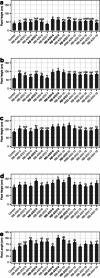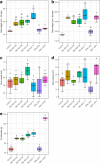Harnessing PGPRs from Asparagus officinalis to Increase the Growth and Yield of Zea mays L
- PMID: 39836327
- PMCID: PMC11750925
- DOI: 10.1007/s00248-025-02490-8
Harnessing PGPRs from Asparagus officinalis to Increase the Growth and Yield of Zea mays L
Abstract
Microbial biotechnology employs techniques that rely on the natural interactions that occur in ecosystems. Bacteria, including rhizobacteria, play an important role in plant growth, providing crops with an alternative that can mitigate the negative effects of abiotic stress, such as those caused by saline environments, and increase the excessive use of chemical fertilizers. The present study examined the promoting potential of bacterial isolates obtained from the rhizospheric soil and roots of the Asparagus officinalis cultivar UF-157 F2 in Viru, la Libertad, Peru. This region has high soil salinity levels. Seventeen strains were isolated, four of which are major potential plant growth-promoting traits, and were characterized based on their morphological and molecular characteristics. These salt-tolerant bacteria were screened for phosphate solubilization, indole acetic acid, deaminase activity, and molecular characterization by 16S rDNA sequencing. Fifteen samples were from saline soils of A. officinalis plants in the northern coastal desert of San Jose, Lambayeque, Peru. The bacterial isolates were screened in a range of salt tolerances from 3 to 6%. Isolates 05, 08, 09, and 11 presented maximum salt tolerance, ammonium quantification, phosphate solubilization, and IAA production. The four isolates were identified by sequencing the amplified 16S rRNA gene and were found to be Enterobacter sp. 05 (OQ885483), Enterobacter sp. 08 (OQ885484), Pseudomonas sp. 09 (OR398704) and Klebsiella sp. 11 (OR398705). These microorganisms promoted the germination of Zea mays L. plants, increased the germination rates in the treatments with chemical fertilizers at 100% and 50%, and the PGPRs increased the height and length of the roots 40 days after planting. The beneficial effects of salt-tolerant PGPR isolates isolated from saline environments may lead to new species that can be used to overcome the detrimental effects of salt stress on plants. The biochemical response and inoculation of the three isolates prove the potential of these strains as sources of products to develop new compounds, confirming their potential as biofertilizers for saline environments.
Keywords: Biofertilizer; Microbial organism; Plant growth promotion; Saline environments; Siderophore; Solubilization ammonium; Solubilization phosphate.
© 2025. The Author(s).
Conflict of interest statement
Declarations. Competing Interests: The authors declare no competing interests.
Figures




Similar articles
-
Rhizobacterial Isolates from Prosopis limensis Promote the Growth of Raphanus sativus L. Under Salt Stress.Curr Microbiol. 2023 Jul 5;80(8):269. doi: 10.1007/s00284-023-03379-w. Curr Microbiol. 2023. PMID: 37402857 Free PMC article.
-
Phylogenetic analysis of halophyte-associated rhizobacteria and effect of halotolerant and halophilic phosphate-solubilizing biofertilizers on maize growth under salinity stress conditions.J Appl Microbiol. 2020 Feb;128(2):556-573. doi: 10.1111/jam.14497. Epub 2019 Nov 13. J Appl Microbiol. 2020. PMID: 31652362
-
Isolation of plant-growth-promoting rhizobacteria from rhizospheric soil of halophytes and their impact on maize (Zea mays L.) under induced soil salinity.Can J Microbiol. 2015 Apr;61(4):307-13. doi: 10.1139/cjm-2014-0668. Epub 2015 Feb 11. Can J Microbiol. 2015. PMID: 25776270
-
Halo-tolerant plant growth-promoting bacteria-mediated plant salt resistance and microbiome-based solutions for sustainable agriculture in saline soils.FEMS Microbiol Ecol. 2025 Apr 14;101(5):fiaf037. doi: 10.1093/femsec/fiaf037. FEMS Microbiol Ecol. 2025. PMID: 40194942 Free PMC article. Review.
-
Transformative strategies for saline soil restoration: Harnessing halotolerant microorganisms and advanced technologies.World J Microbiol Biotechnol. 2025 Apr 28;41(5):140. doi: 10.1007/s11274-025-04342-6. World J Microbiol Biotechnol. 2025. PMID: 40289223 Review.
References
-
- García-Lara S, Serna-Saldivar SO (2019) Corn history and culture. Corn 1:1–8
-
- Galinat WC (1988) The origin of corn. In: Sprague GF, Dudley JW (eds) Corn and corn improvement. American Society of Agronomy, Madison, pp 1–31
-
- McCool WC, Anderson AS, Baide AJN, Gonzalez T, Codding BF (2024) Evaluating the relationships between climate change, population pressure, economic intensification, and childhood stress in the Prehispanic Nasca region of Peru. Quatern Int 689:120–134. 10.1016/j.quaint.2023.06.003
-
- Liu Y, Lan X, Hou H, Ji J, Liu X, Lv Z (2024) Multifaceted ability of organic fertilizers to improve crop productivity and abiotic stress tolerance: review and perspectives. Agronomy 14(6):1141. 10.3390/agronomy14061141
MeSH terms
Substances
LinkOut - more resources
Full Text Sources
Molecular Biology Databases
Miscellaneous

